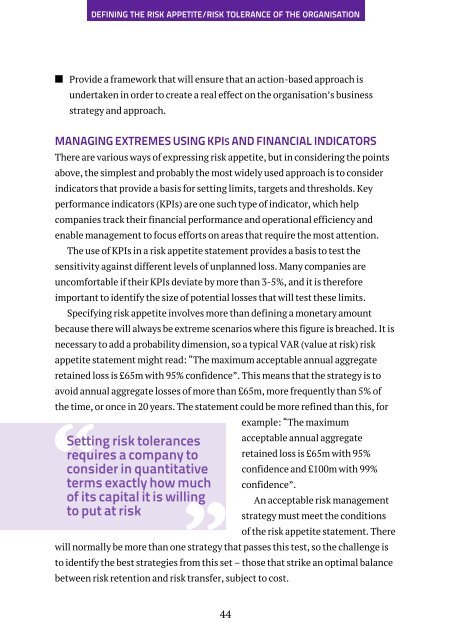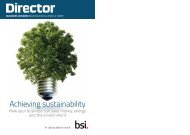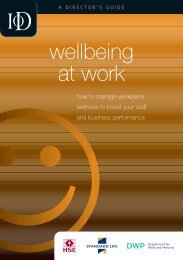Click here to download a pdf - Director Magazine
Click here to download a pdf - Director Magazine
Click here to download a pdf - Director Magazine
Create successful ePaper yourself
Turn your PDF publications into a flip-book with our unique Google optimized e-Paper software.
DEFINING THE RISK APPETITE/RISK TOLERANCE OF THE ORGANISATION■ Provide a framework that will ensure that an action-based approach isundertaken in order <strong>to</strong> create a real effect on the organisation’s businessstrategy and approach.MANAGING EXTREMES USING KPIS AND FINANCIAL INDICATORST<strong>here</strong> are various ways of expressing risk appetite, but in considering the pointsabove, the simplest and probably the most widely used approach is <strong>to</strong> considerindica<strong>to</strong>rs that provide a basis for setting limits, targets and thresholds. Keyperformance indica<strong>to</strong>rs (KPIs) are one such type of indica<strong>to</strong>r, which helpcompanies track their financial performance and operational efficiency andenable management <strong>to</strong> focus efforts on areas that require the most attention.The use of KPIs in a risk appetite statement provides a basis <strong>to</strong> test thesensitivity against different levels of unplanned loss. Many companies areuncomfortable if their KPIs deviate by more than 3-5%, and it is t<strong>here</strong>foreimportant <strong>to</strong> identify the size of potential losses that will test these limits.Specifying risk appetite involves more than defining a monetary amountbecause t<strong>here</strong> will always be extreme scenarios w<strong>here</strong> this figure is breached. It isnecessary <strong>to</strong> add a probability dimension, so a typical VAR (value at risk) riskappetite statement might read: “The maximum acceptable annual aggregateretained loss is £65m with 95% confidence”. This means that the strategy is <strong>to</strong>avoid annual aggregate losses of more than £65m, more frequently than 5% ofthe time, or once in 20 years. The statement could be more refined than this, forexample: “The maximumSetting risk <strong>to</strong>lerancesacceptable annual aggregaterequires a company <strong>to</strong> retained loss is £65m with 95%consider in quantitative confidence and £100m with 99%terms exactly how much confidence”.of its capital it is willingAn acceptable risk management<strong>to</strong> put at riskstrategy must meet the conditionsof the risk appetite statement. T<strong>here</strong>will normally be more than one strategy that passes this test, so the challenge is<strong>to</strong> identify the best strategies from this set – those that strike an optimal balancebetween risk retention and risk transfer, subject <strong>to</strong> cost.44









